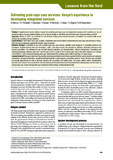| dc.contributor.author | Kilonzo N. | |
| dc.contributor.author | Theobald SJ. | |
| dc.contributor.author | Nyamato E. | |
| dc.contributor.author | Ajema C. | |
| dc.contributor.author | Muchela H. | |
| dc.contributor.author | Kibaru J. | |
| dc.contributor.author | Rogena Emily Adhiambo. | |
| dc.contributor.author | Taegtmeyer M. | |
| dc.date.accessioned | 2013-07-17T07:21:58Z | |
| dc.date.available | 2013-07-17T07:21:58Z | |
| dc.date.issued | 2009-07 | |
| dc.identifier.citation | Bull World Health Organ. 2009 Jul;87(7):555-9 | en |
| dc.identifier.uri | http://www.ncbi.nlm.nih.gov/pubmed/19649371 | |
| dc.identifier.uri | http://erepository.uonbi.ac.ke:8080/xmlui/handle/123456789/48310 | |
| dc.description.abstract | Problem Comprehensive service delivery models for providing post-rape care are largely from resource-rich countries and do not
translate easily to resource-limited settings such as Kenya, despite an identified need and high rates of sexual violence and HIV.
Approach Starting in 2002, we undertook to work through existing governmental structures to establish and sustain health sector
services for survivors of sexual violence.
Local setting In 2003 there was a lack of policy, coordination and service delivery mechanisms for post-rape care services in Kenya.
Post-exposure prophylaxis against HIV infection was not offered.
Relevant changes A standard of care and a simple post-rape care systems algorithm were designed. A counselling protocol was
developed. Targeted training that was knowledge-, skills- and values-based was provided to clinicians, laboratory personnel and
trauma counsellors. The standard of care included clinical evaluation and documentation, clinical management, counselling and
referral mechanisms. Between early 2004 and the end of 2007, a total of 784 survivors were seen in the three centres at an average
cost of US$ 27, with numbers increasing each year. Almost half (43%) of these were children less than 15 years of age.
Lessons learned This paper describes how multisectoral teams at district level in Kenya agreed that they would provide post-exposure
prophylaxis, physical examination, sexually transmitted infection and pregnancy prevention services. These services were provided
at casualty departments as well as through voluntary HIV counselling and testing sites. The paper outlines which considerations
they took into account, who accessed the services and how the lessons learned were translated into national policy and the scale-up
of post-rape care services through the key involvement of the Division of Reproductive Health | en |
| dc.language.iso | en | en |
| dc.publisher | WHO | en |
| dc.title | Delivering post-rape care services: Kenya's experience in developing integrated services. | en |
| dc.type | Article | en |
| local.publisher | Department of Pathology, University of Nairobi | en |
| local.publisher | Liverpool VCT, Care & Treatment, Nairobi, Kenya. | en |
| local.publisher | Liverpool School of Tropical Medicine, Liverpool, England | en |


